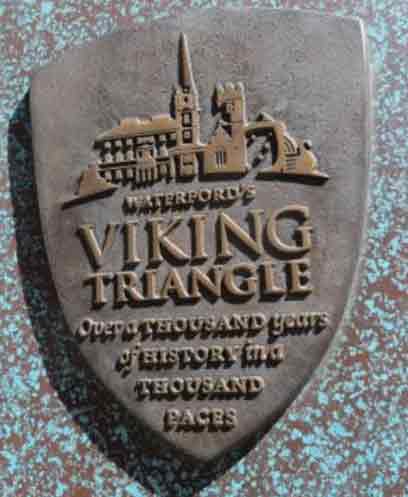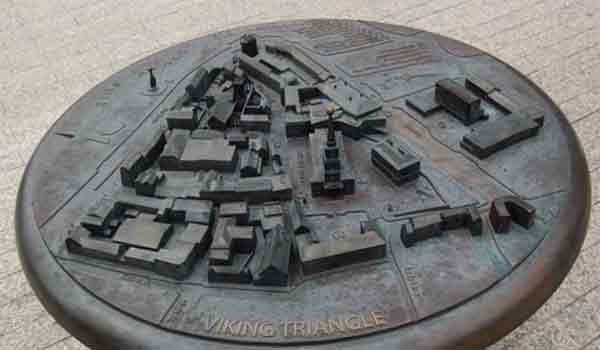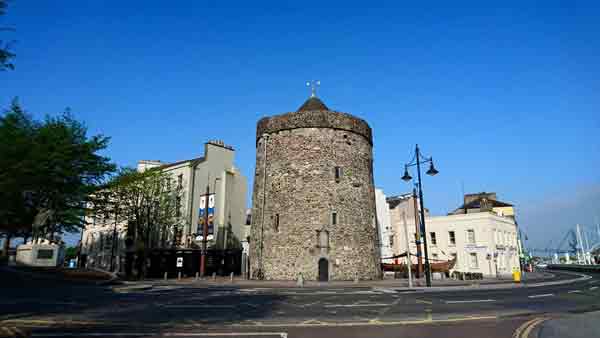Reginald’s Tower, with its extensive history is located in the heart of Waterford’s Viking Triangle, within Ireland’s oldest City. It is a jewel in The Crown of Ireland’s Ancient East.
Contact Information
Reginald’s Tower,
The Quay,
Waterford.
Phone – 00353 (0)51 304220
E-mail – reginaldstower@opw.ie
Website – www.waterfordtreasures.com
Admission Fees & Opening Time.
Adult – €4.00
Senior / Group – €3.00
Child / Student – €2.00
Family – €10.00
Opening Hours
Reginald’s Tower is opening all year.
January – March (beginning of), Wednesday – Sunday 9:30 – 17:00
Late March – Mid December
Open Daily 9:30 – 17:30
Reginald’s Tower is closed for Christmas from 24th of December – January 6th.
Tour information
The tour of Reginald’s Tower takes approximately 1 hour.
Last admissions are 30 minutes before closing.
Guided Tours of Reginald’s Tower is carried out by the OPW staff at Reginald’s Tower.
Please note that there is no disabled access to the upper floors of Reginald’s Tower.
Sinead’s Thoughts on Reginald’s Tower.
Reginald’s Tower is the historic Tower situated proudly on the eastern end of the Waterford Quays and is one of the jewels in the crown of Ireland’s Ancient East. It dominates the Quay sitting strongly, telling us the epic stories of Waterford’s glorious historic past. Reginald’s Tower is Ireland’s oldest surviving Civic building. The Tower is the cornerstone of the vibrant and intriguing history of Waterford, dramatically centered in the heart of Waterford’s Viking Triangle, standing as testament to the foundation of Ireland’s oldest City and has been a constant witness to an epic history that has captured our imaginations and has endured for over 1100 years.
Waterford is our hometown and it is an honor and privilege to be able to write about Reginald’s Tower, it is a building that has always been in our lives, standing strong on The Quays in Waterford, watching us everyday.
When asked about Waterford it is one of the places we advise any of our friends and family, who visit, to go and see. The history of Waterford is something we are very proud of and hold dearly. Reginald’s Tower is a magnificent structure with a history that is completely mind blowing and is one of the many historic and cultural attractions within our beautiful Waterford City.

Common Question: Where is the oldest city in Ireland? Waterford City has the distinct honor of being Ireland’s oldest City. This site and Tower have been witness to some of the most important events in Irish History and has played a central role in many of Irelands most important events and has been graced and conquered by some of the most famous and infamous characters in Ireland’s history.
Waterford is a city that has been conquered and survived, Waterford and its people have always adapted and risen from the flames of invaders and conquests to become one of Ireland most important and beloved cities in Ireland.
From early Prehistoric Ireland, though the conquest of the Vikings, Normans and Cromwellian Invaders, Waterford and its unique history have withstood the test of time. It is a spectrally beautiful city situated on the banks of the majestic River Suir, in the South East of Ireland, Waterford is soaked in culture and history, that is completely unique. Waterford is still a busy port, which lead to it being one of Irelands most important trade centre’s, with this easy assess to the world’s trade routes also lead to raiders such as the Vikings to our shores and they saw Waterford’s potential as a defensive settlement and the magnificent Norman Tower known as Reginald’s Tower and its site situated on the quay in Waterford city has been the epicenter of Waterford’s Historic development, both defensively and culturally.
The Foundation of Waterford before the arrival of The Vikings is assumed to have been by Native Irish peoples who had possibly carried out a nomadic lifestyle following herds and perhaps setting up small hamlets and with the transition of eras, would have turned to an agricultural existence. These peoples would not have established a major defensive settlement. The major established settlements in Waterford would have been the Monastic sites of Ardmore and Lismore. These sites would have been very tempting targets of raid by The Viking Invaders.
The arrival of The Vikings in Waterford is an event that would forever change the landscape of this area. It is believed that Waterford was used as a Viking seasonal settlement from the year 853AD, these seasonal settlements were used in the summer months to carry out lightening raids on centre’s of wealth such as the monasteries at Ardmore and Lismore. The Vikings would have taken portable wealth by any means necessary and returned to their homelands in Scandinavia for the winter months.
Waterford was perfectly situated on the banks of the River Suir and had natural defensive features with a clear view of the estuary, with water and marsh flanking 3 sides of the encampment, making it perfect for the establishment of a Longport. The Vikings used our rivers as roads and establishing a Longport at Waterford, which gave them access to much of the interior of Irelands South and East, as the River Suir, River Barrow and River Nore, come together to form the Rivers of the 3 Sisters, gave these raiders unlimited access to much of Ireland.
The first established permanent settlement at Waterford is agreed to have been in 914AD, its Norse name was Vadrarfjordr, which would eventually become known as Waterford or in Irish Port Lairge. The meaning of Vadrarfjordr is not completely clear but it is, believed to have meant, Fjord of the rams, perhaps referring to the exportation of sheep from Waterford. Waterford had many famous Viking Kings including Ivar of Waterford and Regnall Ur Imair.
Reginald’s Tower situated at the epicenter of The Viking Dundory also known, as the Viking Triangle, which was first established as part of the Viking Defensive features of Waterford. In 917AD Regnall ur Imair became King of Waterford and was also King of York, another major Norse stronghold. Regnall, son of Ivar of Waterford is thought to have been the grandson of Ivar the Boneless, a name that is probably very familiar to any of our readers who follow the History Channel series The Vikings, which we must also mention is filmed in Ireland.
Reginald’s Tower dates from 1003 and formed part of Waterford defensive features known as the Dundory (Viking defensive triangle). It would have started life as a wooden structure at this time, as Vikings usually built with wood and would have later been replaced with a stone structure. There were extensive excavations carried out in the 1990’s proving that some of Waterford defensives were in fact constructed using stone before the Norman invasion of Ireland began in 1170.
As the Vikings became came part of Irish Society we see the establishment of an era known as Hiberno-Norse era in Waterford, where Irish and Norse culture mixed and the Norse became a part of our native histories and saw Waterford established as an essential trading port a legacy that endures today as one of Irelands major Port Cities, the raiders had transitioned into traders.
During the Late 10th Century and early 11th Century Waterford was conquered by the Irish King Brian Boru, after which he formed an alliance with the Hiberno-Norse of Waterford, which assured their assistance in the infamous Battle of Clontarf in 1014 and was put under the control of his O’Brien dynasty, Ragnall’s daughter was also married to one of Brian Boru’s son’s. Control of Waterford gave the Irish High Kings access to the wider world of International trade and marked the decline of Viking control in Waterford. Waterford’s importance as a trading Port made it an essential target of conquest during the Norman Invasion of Ireland.
The Norman Invasion saw the landscape of Ireland change forever with the establishment of massive defensive features being constructed in the Norman power centers of Ireland; these Castles are now one of the most prominent historical features on the Irish Landscape. Waterford was to play a central role in the Norman Invasion of Ireland. Dermot MacMurragh, the deposed King of Leinster, sought the assistance of the Norman King Henry II, he needed the help of the Normans to regain control of his lands in Ireland and that help arrived in the form of an infamous Norman Lord Strongbow, Richard De Clare Earl of Pembroke.
The Normans invaded the Viking stronghold of Waterford in 1170. It was a bloody battle that ended with a break in the walls and resulted in the capture of the town signaling the fall of the city to the infamous Strongbow. The peoples of Waterford could not defend against the arsenal of the Normans and their use of Calvary and the new weapons, armor and military tactics used by the fearsome Normans warriors. The legend of Reginald’s Tower is that Strongbow married Aoife MacMurragh, daughter of King Dermot MacMurragh at this site, thus making Strongbow the heir to the Kingdom of Leinster and the most powerful Norman Lord in Ireland.

Waterford was the site of the first British Royal visit to Ireland, when in 1172 King Henry II visited Ireland, mainly to take control of Strongbow, who the King did not trust and Henry II felt had become to powerful. The Reginald’s Tower we see today has a history that dates from 1172.
Reginald’s Tower has had many functions in its long and dramatic life, it is said that the tower was sometimes used as a Royal residence. Reginald’s Tower was used as a prison and as a mint. The coins struck at Reginald’s tower were struck with “Cavitas Waterford” on one side.
Reginald’s Tower today dates from the 13th-14th century and part of the rebuilding of the city defenses commissioned by Prince John in 1185. It is the largest and most dominant of 6 surviving towers, which guarded the Medieval walled City of Waterford the use of the Tower’s cannons was the first time in Irish History that heavy artillery was used in the defense of an Irish City, giving it the caviate of “urbs Intacia Manet”, “The unconquered city”
Cromwell laid siege to Waterford in 1649 and failed to capture the city at this time but succeeded in 1650. In 1901 Reginald’s Tower came into the possession of Waterford Corporation and was the main residence of Waterford city Constable until 1954. It was used an air raid shelter during the emergency of WWII. Reginald’s Tower has undergone extensive restoration and conservation in recent years.
It is home to some of the most spectacular artifacts ever found from Viking Age Ireland and It also now houses Waterford’s many amazing Artifacts of Viking age Waterford that were uncovered and preserved from the Woodstown excavation, up river from the City. These excavations uncovered some of the finest and well-preserved artifact from a Viking settlement anywhere in Europe. A visit to Reginald’s Tower is an amazing experience that will inspire you to explore further into Waterford past and all that Waterford has to offer.

